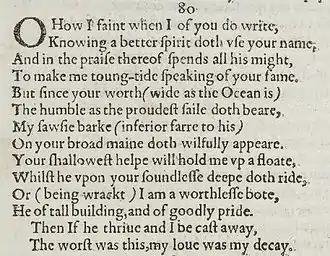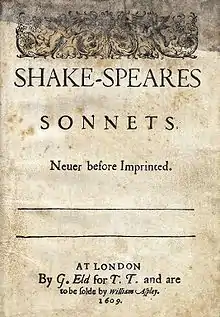Sonnet 80
Sonnet 80 is one of 154 sonnets published by the English playwright and poet William Shakespeare in 1609. It is part of the Fair Youth sequence, and the third sonnet of the Rival Poet sequence.
| Sonnet 80 | |||||||
|---|---|---|---|---|---|---|---|
 Sonnet 80 in the 1609 Quarto | |||||||
| |||||||
Exegesis
The poet's strategy in this sonnet is to present himself as humble and less talented than the other poet, and to the urge the young man to at least value the poet's love. The sonnet uses nautical metaphors. The poet begins with a conventional seeming opening line, "O, how I faint when I of you do write”, causing the reader to expect, in a manner like Petrarch, that a list of the young man's virtues will follow. Instead it is revealed that the poet faints at the thought that there is a rival. The poet acknowledges that a superior poet is now using the young man's name, and is spending all his strength praising that name in order to tongue-tie the poet, which suggests the other poet does not have the substance of the young man as his primary focus.
The young man's worth is said by the poet to be as great as the ocean, and can bear both vessels — the humble and the proud. The poet portrays himself as a smaller ship, that does "wilfully appear” (full of "Will"), while the other poet more resembles the large Spanish galleons (line 12), which calls to mind the English success with smaller faster ships against the more lumbering Spanish Armada.
The young man is transformed during the sonnet from one who is at first vastly tolerant, to one who is then a ship wrecker, and one who might cast away a relationship (line 13). The first line of the couplet gives the young man the power to cause one to thrive and the other to be cast away, but the last line shows that is delusional, since the poet maintains his responsibility for his own decay, a word that Sonnet 79 confines to a lapse in poetic talent ("But now my gracious numbers are decayed").[2][3]
Structure
Sonnet 80 is an English or Shakespearean sonnet, which has three quatrains, followed by a final rhyming couplet. It follows the rhyme scheme ABAB CDCD EFEF GG and is composed in iambic pentameter, a metre of five feet per line, with two syllables in each foot accented weak/strong. Most of the lines are examples of regular iambic pentameter, including the 10th line:
× / × / × / × / × / Whilst he upon your soundless deep doth ride; (80.10)
- / = ictus, a metrically strong syllabic position. × = nonictus.
The meter suggests a few variant pronunciations: the 2nd line's "spirit" functions as 1 syllable (possibly pronounced as spear't, sprite, sprit, or spurt[4]), the 7th line's "inferior" as 3 syllables, and the 9th line's "shallowest" as 2.[5]
The sonnet exhibits some metrical variations, for example, an initial reversal in the 2nd line:
/ × × / × / × / × / Knowing a better spirit doth use your name, (80.2)
Reversals can also occur mid-line, as occurs in line 5; and some may be optional, as the possible initial reversals in lines 1 and 13. Also possible is the rightward movement of the first ictus (the resulting four-position figure, × × / /, is sometimes referred to as a minor ionic):
× × / / × / × / × / On your broad main doth wilfully appear. (80.8)
Notes
- Shakespeare, William. Duncan-Jones, Katherine. Shakespeare’s Sonnets. Bloomsbury Arden 2010. p. 271 ISBN 9781408017975.
- Shakespeare, William. Duncan-Jones, Katherine. Shakespeare’s Sonnets. Bloomsbury Arden 2010. p. 270 ISBN 9781408017975.
- Hammond, Gerald. The Reader and the Young Man Sonnets. Barnes & Noble. 1981. p. 100-102. ISBN 978-1-349-05443-5
- Booth 2000, p. 262.
- Booth 2000, p. 274.
References
- First edition and facsimile
- Shakespeare, William (1609). Shake-speares Sonnets: Never Before Imprinted. London: Thomas Thorpe.
- Lee, Sidney, ed. (1905). Shakespeares Sonnets: Being a reproduction in facsimile of the first edition. Oxford: Clarendon Press. OCLC 458829162.
- Variorum editions
- Alden, Raymond Macdonald, ed. (1916). The Sonnets of Shakespeare. Boston: Houghton Mifflin Company. OCLC 234756.
- Rollins, Hyder Edward, ed. (1944). A New Variorum Edition of Shakespeare: The Sonnets [2 Volumes]. Philadelphia: J. B. Lippincott & Co. OCLC 6028485.
- Modern critical editions
- Atkins, Carl D., ed. (2007). Shakespeare's Sonnets: With Three Hundred Years of Commentary. Madison: Fairleigh Dickinson University Press. ISBN 978-0-8386-4163-7. OCLC 86090499.
- Booth, Stephen, ed. (2000) [1st ed. 1977]. Shakespeare's Sonnets (Rev. ed.). New Haven: Yale Nota Bene. ISBN 0-300-01959-9. OCLC 2968040.
- Burrow, Colin, ed. (2002). The Complete Sonnets and Poems. The Oxford Shakespeare. Oxford: Oxford University Press. ISBN 978-0192819338. OCLC 48532938.
- Duncan-Jones, Katherine, ed. (2010) [1st ed. 1997]. Shakespeare's Sonnets. The Arden Shakespeare, Third Series (Rev. ed.). London: Bloomsbury. ISBN 978-1-4080-1797-5. OCLC 755065951.
- Evans, G. Blakemore, ed. (1996). The Sonnets. The New Cambridge Shakespeare. Cambridge: Cambridge University Press. ISBN 978-0521294034. OCLC 32272082.
- Kerrigan, John, ed. (1995) [1st ed. 1986]. The Sonnets ; and, A Lover's Complaint. New Penguin Shakespeare (Rev. ed.). Penguin Books. ISBN 0-14-070732-8. OCLC 15018446.
- Mowat, Barbara A.; Werstine, Paul, eds. (2006). Shakespeare's Sonnets & Poems. Folger Shakespeare Library. New York: Washington Square Press. ISBN 978-0743273282. OCLC 64594469.
- Orgel, Stephen, ed. (2001). The Sonnets. The Pelican Shakespeare (Rev. ed.). New York: Penguin Books. ISBN 978-0140714531. OCLC 46683809.
- Vendler, Helen, ed. (1997). The Art of Shakespeare's Sonnets. Cambridge, MA: The Belknap Press of Harvard University Press. ISBN 0-674-63712-7. OCLC 36806589.
.png.webp)

